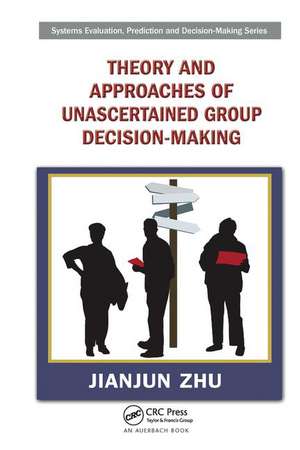Theory and Approaches of Unascertained Group Decision-Making: Systems Evaluation, Prediction, and Decision-Making
Autor Jianjun Zhuen Limba Engleză Paperback – 12 oct 2016
Written by Jianjun Zhu, director of the Chinese Society for Optimization, Overall Planning, and Economic Mathematics, the book starts by examining case studies of group decision making. It discusses consistency measuring and ranking methods of interval number reciprocal judgment matrix and interval number complementary judgment matrix. Next, it presents an unascertained number preference and a three-point interval number preference.
Investigating linguistic preferences, the text provides two consistencies definitions. It considers the aggregating methods of several uncertain preferences as well as the multistage aggregating model of uncertain preference. The final chapter proposes an aggregating model of multistage linguistic information based on TOPSIS.
The research in this book is supported by a number of scientific foundations from the People’s Republic of China, including the National Natural Science Foundation of China; the Social Science Foundation of China, Jiangsu Province; and the Soft Science Foundation of China.
Preț: 305.97 lei
Preț vechi: 356.63 lei
-14% Nou
Puncte Express: 459
Preț estimativ în valută:
58.55€ • 61.13$ • 48.46£
58.55€ • 61.13$ • 48.46£
Carte tipărită la comandă
Livrare economică 04-18 aprilie
Preluare comenzi: 021 569.72.76
Specificații
ISBN-13: 9781138198982
ISBN-10: 1138198986
Pagini: 258
Ilustrații: 17
Dimensiuni: 156 x 234 mm
Greutate: 0.45 kg
Ediția:1
Editura: CRC Press
Colecția Auerbach Publications
Seria Systems Evaluation, Prediction, and Decision-Making
Locul publicării:Boca Raton, United States
ISBN-10: 1138198986
Pagini: 258
Ilustrații: 17
Dimensiuni: 156 x 234 mm
Greutate: 0.45 kg
Ediția:1
Editura: CRC Press
Colecția Auerbach Publications
Seria Systems Evaluation, Prediction, and Decision-Making
Locul publicării:Boca Raton, United States
Public țintă
Professional and Professional Practice & DevelopmentCuprins
Using Condition of Uncertainty Preference Information. Decision Mechanism of Uncertainty Preference Information. Multi Uncertainty Preference Information Consistent-transformation Approach. Aggregation Approach on Multi Style Uncertainty Preference Information. Aggregation of Multi Style Uncertainty Preference Information based on Timing Characteristics. Dynamic Characteristics and Evolution to Group Decision Effect in Decision Environment Disturbance.
Notă biografică
Dr. Jianjun Zhu holds a Ph.D. degree in information science and systems engineering and is currently an associate professor at NUAA. His primary interests of research are in the theories of group decision-making, multi-attribute decision-making and complicated decision-making. He has completed two National Natural Science Foundation projects, one State 863 Program CIMS project, and one national defense research project, as a major participant. Moreover, he has completed a cooperation project of the Shanghai Baosteel Company, and managed the postdoctoral research fund projects of Chinese post-doctoral research projects in Jiangsu Province. Dr. Zhu has published more than 20 research papers in the Journal of Systems Engineering, Management Science Journal, Control and Decision-Making, and Systems Engineering Theory and Practice.
Descriere
The question of how to aggregate structural uncertainties of multiple variables to determine the group preference, on the basis of the complexity of group decision-making, is a problem that urgently waits for a resolution. This book expresses the complexity existing in each group decision-making process by employing complex networks and studying various methods of aggregating preference information from various unascertained, time-series based decision-making groups’ structures. It covers the decision-making mechanism of unascertained preference information, aggregation of unascertained preference information, and various methods of aggregating preference information in dynamic environments.











